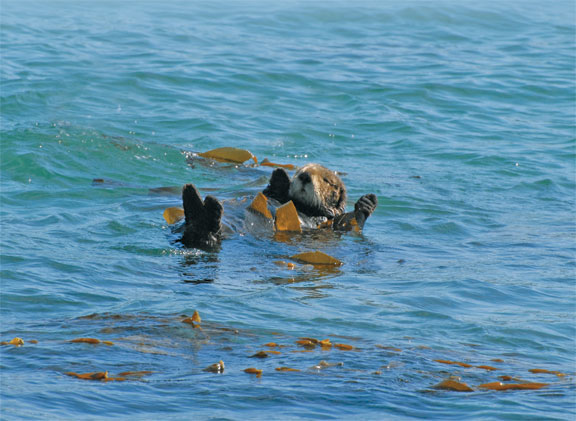Since sea otters rarely spend any time on land most people will never see the lower part of them, which is usually underwater. The body resembles that of the otter’s close cousin the weasel and there is a substantial 10- to 12-inch long tail.
Unlike most marine mammals, sea otters swim on their backs, not their stomachs, using their webbed and flattened hind feet like paddles. Their unusual forefeet can function like hands or paws. They are small and round with little fingers and partially retractable claws.
Two species of these extraordinary mammals, the southern sea otter and the northern sea otter, are found off the West Coast of North America. This article focuses on the southern sea otter (Enhydra lutris nereis), which lives in California.
Otters were once abundant off the West Coast but the demand for their thick, very fine fur led to their being hunted almost to extinction. Both southern and northern sea otters are listed as threatened.
Today’s southern sea otters are the descendants of 50 that lived off Big Sur in 1938. At present the coastal population numbers nearly 3,000 animals. An additional 68 or so live off San Nicolas Island. Otters were translocated there beginning in 1987 in an attempt to establish a separate colony. However, many of those taken to the island swam back to the mainland and the program was discontinued in 2012. Other than San Nicolas, southern sea otters are found from San Mateo County in the north to Santa Barbara County in the south. Elkhorn Slough currently hosts the largest population of about 100 individuals. Solo sea otters can show up nearly anywhere along the coast. There have been recent sightings off Laguna Beach and San Clemente (the city).
Besides weasels, sea otters are close cousins of skunks and river otters. They are among the smallest marine mammals in North American. An Enhydra lutris male can be about four and a half feet long and weigh as much as 87 pounds. The female can be four feet long and weigh 60 pounds. Sea otters may live about 20 years and produce one pup every two years or so.
Although otters have a considerable cuteness quotient, mating is their dark side. It’s downright dangerous for the female. The male holds onto her by grasping her nose or the side of her face with his teeth, sometimes resulting in severe injuries and death. The bleeding from these wounds may attract great white sharks. While great whites don’t eat otters, they bite them and the bites can be fatal. Sometimes the female is held underwater by her mate for so long that she drowns.
While breeding and pupping occur throughout the year, pupping peaks from February to June. Pups can be born on land or at the ocean’s surface. The mother cares for her baby for at least six months, sometimes longer.
While white fur doesn’t mean an otter is old and those of any gender/age may have it, a silver/blond color indicates an older otter. A long, thick, woolly coat of brownish hair means the animal is a pup, less than two months old. Since the hair prevents the pup from diving, it has to remain on the surface while its mother searches for her food underwater. According to a California Fish and Wildlife booklet, Marine Mammals of California, “The pup will reach for its mother as soon as she surfaces, presenting a very touching mother-pup display. Often the pup will cry for its mother when the mother is foraging or if separated during stormy sea conditions. The cry can be heard for long distances.”
Sea otters are social animals and may raft together in groups of up to 100, with females and pups in one group and males in another. All sea otters rest and sleep on the surface. In order to keep from drifting, they roll around in kelp until they are wrapped up in it. They are also known to hold paws to prevent drifting apart. Sea otters have good eyesight and use their whiskers to sense vibrations in the water.
While northern sea otters eat fish, southern sea otters do not. Both species eat invertebrates such as crabs, snails, urchins, clams and mussels. To crack open the shells of their prey, southern sea otters float on their backs with the prospective meal on their chests and pound it with a rock. Since sea otters don’t have blubber to keep them warm they must eat as much as 25 percent of their weight in food every day to maintain a high metabolism. They are also kept warm by the world’s densest fur, which needs hours of grooming every day to remain waterproof.
Otters can be seen at numerous places along the coast. Although they stay fairly close to the shore they usually keep their distance from humans. My favorite place to photograph them in Central California is Target Rock, on the southern side of Morro Rock in Morro Bay.
The author wishes to thank Genny and Shane Anderson for their help in the preparation of this article.
Southern Sea Otter Info
Phylum: Chordata
Subphylum: Vertebrata
Superclass: Gnathostomata
Superclass: Tetrapoda
Class: Mammalia
Order: Carnivora
Suborder: Caniformia
Family: Mustelidae
Genus/Species: Enhydra lutris lutris
Subspecies: Enhydra lutris nereis (Southern Sea Otter) Enhydra lutris kenyoni (Northern Sea Otter)










